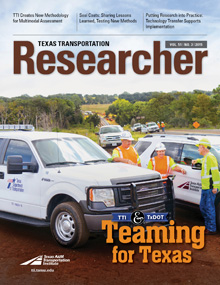Helping El Paso Manage Growing Pains
The Office of the State Demographer projects Texas’ population will rise from 25.2 million in 2010 to 33.9 million in 2030. That’s a 35 percent increase in the state’s population, and the growth isn’t just happening in cities like Austin, Dallas or Houston — it’s happening statewide.

In El Paso, commutes of 20 miles at peak travel times can take up to an hour. Local residents are spending more time in traffic, and their idling vehicles are adding to the region’s air pollution. In fact, the U.S. Environmental Protection Agency (EPA) considers El Paso a non-attainment area, meaning the region fails to meet EPA’s air-quality standards and risks losing federal funding until it does.
Researchers at the Texas A&M Transportation Institute’s (TTI’s) Center for International Intelligent Transportation Research have come up with a new methodology to assist El Paso’s metropolitan planning organization (MPO) in developing a multimodal plan for the region aimed at decreasing congestion and pollution by encouraging alternate modes of travel. Once proven in El Paso, the methodology could be used by the Texas Department of Transportation or other communities around the state.

“We’re currently assessing how our transportation system needs to look in the future,” explains Michael Medina, executive director of the El Paso MPO. “To do that, we need to know how people in the region use the different modes — pedestrian, bicycle, transit — as well as how they might feel about using those modes in the future.”
The TTI team, led by Associate Research Engineer Alfredo Sanchez, collected baseline data related to how local residents currently use the biking, walking and transit modes. Researchers are looking at the level of service (LOS) provided by each of the three modes plus the automobile. By relating the LOSs across modes, researchers can identify qualitative measurements for assessing each mode’s efficiency relative to the others.
“We’ve actually created a whole new methodology for doing this,” explains Sanchez. “The others that exist weren’t feasible for making comparisons across modes and didn’t allow for a complete, multimodal trip-based evaluation.”
In other words, if people rode their bikes to a bus stop and then rode the bus to another location from which they walked to their office, existing methodologies didn’t allow for rating the relative benefits each of those modes contributed to the overall trip.

“Our new methodology scores the modes on how efficient they are within the context of a person’s trip,” says Sanchez. “It’s sensitive to a region’s unique demographics and trip factors, like time of day, and uses performance measures of a given mode’s efficiency.”
TTI used easily accessible data to run its analysis, relying heavily on GIS information from existing agencies like Sun Metro (El Paso’s transit agency) and the City of El Paso Department of Transportation. Researchers also employed a travel-demand model that includes census and employment data from 2014 and projections for 2030. They then created a framework for comparing the modes relative to one another.
“Part of what we’re doing is assessing what the El Paso MPO area has in the way of existing multimodal transportation facilities and where gaps occur between modes,” says Sanchez. “It’s those kinds of negative aspects of the current system that might influence users to choose to drive rather than use other travel modes.”
Although the project is ongoing, researchers have already determined that El Paso’s bicycle infrastructure requires significant improvements to facilitate last-mile connectivity for local residents. Eventually, the MPO will use TTI’s research findings to analyze travel behaviors as the beginnings of a strategy to make alternate travel modes more appealing to El Pasoans.

TTI will ultimately provide the MPO with a framework for analyzing and prioritizing multimodal projects, which the MPO can then use to design a system that minimizes congestion and the pollution associated with it. Less pollution and healthier traveling choices, like biking and walking, could help improve citizens’ health. And that could mean fewer societal costs associated with conditions like respiratory disease, obesity and poor cardiovascular health.
“TTI created this methodology for us to use here in El Paso, but with tweaking, it can be applied anywhere,” says Medina. “With it, any local MPO could determine how to increase mobility for its citizens across travel modes.”


